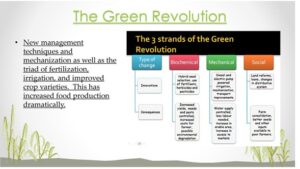Relevance: Sociology: Rural and Agrarian transformation in India: Green revolution and social change
Of all the developmental programmes introduced during the post-independence period the green revolution is considered to have been the most successful. The green revolution led to a substantial increase in agricultural output to the extent that it almost solved India’s food problem.
It also produced significant social and political changes in the Indian village and did bring about an agricultural revolution. In purely economic terms the agricultural sector experienced growth at the rate of 3 to 5 % per annum which was many times more than what the rate of growth had been during the colonial period (less than 1%).

The green revolution conceptualized agrarian change in purely technological terms and was based on the trickle down theory of economic growth. The expression green revolution carried the conviction that agriculture was being peacefully transformed through the quiet working of science and technology, reaping the economic gains of modernization while avoiding the social costs of mass upheaval and disorder usually associated with rapid change.
The term green revolution had been first used during the late 1960s to refer to the effects of the introduction of higher yielding variety HYV seeds of wheat and rice in developing countries.
The new varieties of seeds required fertility enhancing inputs like chemical fertilizers, controlled irrigation conditions and plant -protecting chemicals. The other components were providing cheap institutional credit, price incentives and marketing facilities.
In order to back up the application of new technology on local farms a large number of agricultural universities were also opened in the regions selected for the new programme.
It was under the direct supervision of the Ford Foundation that the Intensive Agricultural Development Programme was started in 1961.
Initially the IADP operated in 14 districts on an experimental basis it was later extended to 114 districts under the name of the Intensive Agriculture Areas Programme in 1965.
Its advocates argued that the new technology was scale neutral and could be used with as much benefit by small as well as big landowners.
However in the actual implementation small holdings were not found to be viable units for technological change. Participating in the green revolution did not mean the same thing to smaller farmers as it did to bigger farmers.
While bigger farmers had enough surplus of their own to invest in the new capital-intensive farming for smaller landowners it meant additional dependence on borrowing generally from informal sources.
Although theoretically the new technology was scale neutral it was certainly not resource neutral. The new technology also compelled widespread involvement with the market.
Cultivators in post-green revolution agriculture had to buy all farm inputs from the market for which they often had to take credit from traders or institutional sources. In order to clear the debts they had no choice but to sell the farm yield in the market even when they needed to keep it for their own consumption.
They sold their farm yield immediately after harvesting when prices were relatively low and bought later in the year for consumption when prices were higher.
Thus although the small farmers took to the new technologies the fact that their resources were limited meant that these technologies ushered in a new set of dependencies.
On the other hand it has strengthened the economic and political position of rich farmers. One of the manifestations of the growing market orientation of agrarian production was the emergence of a totally new kind of mobilization of surplus producing farmers who demanded a better deal for the agricultural sector.
These new farmers’ movements emerged almost simultaneously in virtually all the green revolution regions. These movements gained momentum during the decade of the 1980s.
These movements were led by substantial landowners who had benefited most from the developmental programmes and belonged to the numerically large middle -level caste groups whom Srinivas had called the dominant castes.
The members of this new social class not only emerged as a dominant group at village level but they also came to dominate regional /state-level politics in most parts of India.
They had an accumulated surplus that they sought to invest in ever more profitable enterprises. Some of them diversified into other economic activities or migrated to urban areas or entered agricultural trade. Culturally also this new class differed significantly from both the classical peasants and old landlords.
The changes produced by the green revolution also generated an interesting debate among Marxist scholars on the question of defining the prevailing mode of production in Indian agriculture.
The most contentious revolved around whether capitalism had become dominant in Indian agriculture or was still characterized by the semi-feudal mode of production.
Another set of scholars on the basis of their own empirical studies mostly from eastern India asserted that Indian agriculture was still dominated by a semi-feudal mode of production. According to this school landlords cum moneylenders continued to dominate the process of agricultural production.
Peasants and labourers were tied to them through the mechanism of debt that led to forced commercialization of labour and agricultural yield. This produced a self-perpetuating stagnant and exploitative agrarian structure that could be described as semi-feudal. The internal logic of this system worked against any possibility of agricultural growth or the development of capitalism in Indian agriculture.
However towards the end of the debate there seems to have emerged a consensus that though it may have its local specificities and considerable regional variations, the capitalist mode of production was on its way to dominating the agrarian economy of India and that regions which had experienced the green revolution.


One comment